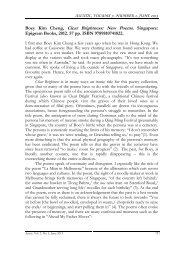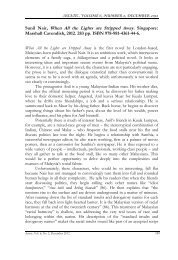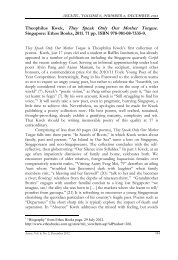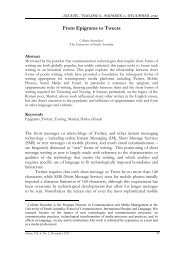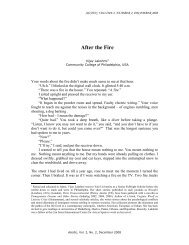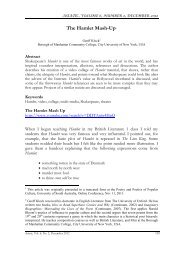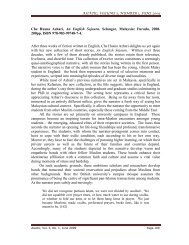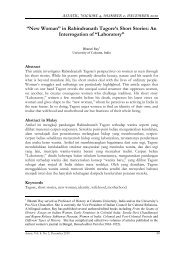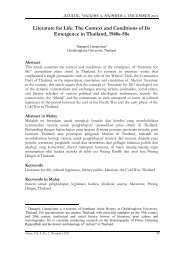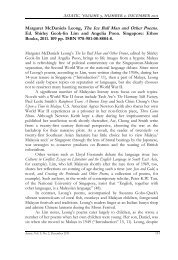Tagore and Education: Creativity, Mutuality and ... - Asiatic IIUM
Tagore and Education: Creativity, Mutuality and ... - Asiatic IIUM
Tagore and Education: Creativity, Mutuality and ... - Asiatic IIUM
You also want an ePaper? Increase the reach of your titles
YUMPU automatically turns print PDFs into web optimized ePapers that Google loves.
ASIATIC, VOLUME 4, NUMBER 1, JUNE 2010<br />
<strong>Tagore</strong> <strong>and</strong> <strong>Education</strong>: <strong>Creativity</strong>, <strong>Mutuality</strong> <strong>and</strong> Survival 1<br />
Kathleen M. O’Connell 2<br />
New College, University of Toronto, Canada<br />
Abstract<br />
This essay examines some of the seminal experiences of Rabindranath’s life that<br />
informed his educational vision <strong>and</strong> helped shape his educational priorities at<br />
Santiniketan. In particular it will explore three central themes that can be said to<br />
characterise the essence of his educational experiment. These themes – creativity,<br />
mutuality <strong>and</strong> survival – which help define his “<strong>Education</strong> for Creative Unity,” can be<br />
said to be the guiding principles for an educational paradigm that he hoped to establish<br />
for his own time <strong>and</strong> as a model for the future. The final section of the essay explores<br />
<strong>Tagore</strong>’s early concerns as an environmentalist through a 1922 fable that he wrote<br />
concerning human greed <strong>and</strong> the role of technology in outstripping the planet.<br />
Keywords<br />
Santiniketan, creativity, mutuality, survival, multiculturalism, environmentalism<br />
Rabindranath’s educational experiment at Santiniketan, which he likened to a<br />
vessel carrying the cargo of his “life’s best treasure” (Letter to G<strong>and</strong>hi) was a<br />
central focus throughout his mature life. He spent forty years of his life<br />
developing a mode of education which facilitated the opening up of a child’s<br />
unique creative personality in a setting harmonious with its immediate<br />
environment <strong>and</strong> the wider world. With his far-reaching vision, Rabindranath<br />
foresaw the coming of the global village <strong>and</strong> the need to educate children in a<br />
way that roots them in their own cultural history, yet enables them to personally<br />
identify with other races <strong>and</strong> cultures, as well as the different strata within a<br />
given society. Today, his consideration of the consolidation of cultures has a<br />
new relevance in international cities as immigration brings multiple cultures<br />
1 An earlier draft of this paper was delivered in 2000 at an international <strong>Tagore</strong> conference<br />
sponsored by the <strong>Tagore</strong> Centre, UK, <strong>and</strong> published in Rabindranath <strong>Tagore</strong>: A Creative Unity,<br />
edited by Amalendu Biswas <strong>and</strong> Charles Gordon-Graham (London: The <strong>Tagore</strong> Centre UK, 2006).<br />
2 Kathleen M. O'Connell teaches courses on South Asia at New College, University of Toronto,<br />
Canada. Her research interests include Rabindranath <strong>Tagore</strong>, Satyajit Ray, <strong>and</strong> Bengali cultural<br />
<strong>and</strong> literary history. Her publications include: Bravo Professor Shonku, translation (Bengali to<br />
English) of three stories by Satyajit Ray (New Delhi: Rupa <strong>and</strong> Co., 1985); Rabindranath <strong>Tagore</strong>:<br />
The Poet as Educator (Kolkata: Visva-Bharati, 2002); <strong>and</strong> Rabindranth <strong>Tagore</strong>: Claiming a<br />
Cultural Icon, jointly edited with Joseph T. O’Connell (Kolkata: Visva-Bharati, 2009).<br />
<strong>Asiatic</strong>, Vol. 4, No. 1, June 2010 65
<strong>Tagore</strong> on <strong>Education</strong>: <strong>Creativity</strong>, <strong>Mutuality</strong> <strong>and</strong> Survival<br />
even closer together within a neighbourhood setting, making the need for an<br />
educational model that promotes inter-cultural underst<strong>and</strong>ing <strong>and</strong> new<br />
combinations of cultural components more compelling.<br />
This essay, rather than concentrating on the history of Santiniketan, will<br />
take a broader approach <strong>and</strong> look first at some of the experiences which helped<br />
shape Rabindranath’s educational vision, <strong>and</strong> at three themes, which I believe<br />
form the foundation for his educational priorities <strong>and</strong> characterise their essence.<br />
These themes – creativity, mutuality <strong>and</strong> survival – which help define his<br />
“<strong>Education</strong> for Creative Unity,” can be said to be the guiding principles for an<br />
educational paradigm which he hoped to establish for his own time <strong>and</strong> as a<br />
model for the future.<br />
<strong>Creativity</strong><br />
Rabindranath has written about the negative effects of his formal schooling,<br />
which he describes as out of touch with Indian culture, mechanical, deadening<br />
of creativity <strong>and</strong> restraining of individual freedom. He has also written about<br />
the positive experience of “subconscious learning” which he experienced in<br />
Jorasanko, the family mansion, where the members of his joint family provided<br />
a rich cultural <strong>and</strong> artistic experience. Also, there were the experiences on the<br />
family estates in East Bengal, where he encountered rural life for the first time,<br />
responding initially in a poetic fashion to the l<strong>and</strong>scape <strong>and</strong> changing seasons,<br />
then compassionately to the great suffering of the villagers as he became aware<br />
of the enormous obstacles they faced. These experiences were important factors<br />
in his creation of a school at Santiniketan, which emphasised the arts <strong>and</strong><br />
cultural sharing, a poetic appreciation of nature, <strong>and</strong> an awareness of the<br />
suffering of others.<br />
At a psychological level, he also writes of three experiences which<br />
profoundly influenced his life <strong>and</strong> helped shape his inner vision regarding the<br />
ideal of creative unity in education <strong>and</strong> other areas of life. There was the early<br />
experience when he was learning to read, <strong>and</strong> disconnected words suddenly<br />
came together as he encountered the rhyming phrase “jal parey/pata narey” (the<br />
water falls/the leaf trembles) in his spelling book. The rhythm of the words<br />
connected him for the first time with a harmonious creative dimension. “I was<br />
no longer a mere student with his mind muffled by spelling lessons,” he writes.<br />
“The rhythmic picture of the tremulous leaves beaten by the rain opened before<br />
my mind the world which does not merely carry information, but a harmony<br />
with my being. The unmeaning fragments lost their individual isolation <strong>and</strong> my<br />
mind revelled in the unity of a vision” (“The Vision” 95).<br />
Then there was the intense <strong>and</strong> definitive experience which occurred at age<br />
eighteen as he stood on a balcony in Calcutta watching an early morning<br />
sunrise: “The invisible screen of the commonplace was removed from all things<br />
<strong>and</strong> all men,” he writes, “<strong>and</strong> their ultimate significance was intensified in my<br />
<strong>Asiatic</strong>, Vol. 4, No. 1, June 2010 66
Kathleen M. O’Connell<br />
mind…. That which was memorable in this experience was its human message,<br />
the sudden expansion of my consciousness in the super-personal world of man”<br />
(“The Vision” 94-95; O’Connell, Rabindranath <strong>Tagore</strong> 105-25). This experience<br />
was followed by an unprecedented outpouring of creative energy, which<br />
affected him throughout his life, <strong>and</strong> which, according to his self-narrative,<br />
provided the experiential base for his concept of a unity that penetrates all<br />
existence. As he noted to C.F. Andrews: “The whole scene was one perfect<br />
music – one marvellous rhythm…. Everyone, even those who bored me,<br />
seemed to lose their outer barrier of personality; <strong>and</strong> I was full of gladness, full<br />
of love, for every person <strong>and</strong> every tiniest thing…. That morning in Free School<br />
Lane was one of the first things which gave me the inner vision, <strong>and</strong> I have<br />
tried to explain it in my poems. I have felt, ever since, that this was my goal: to<br />
express the fullness of life, in its beauty, as perfection – if only the veil were<br />
withdrawn” (Letters to a Friend 24).<br />
A third transforming experience occurred when he was in his early forties<br />
<strong>and</strong> managing the family estates in East Bengal. By his description, it was an<br />
ordinary day when he had finished his morning work <strong>and</strong> stood at the window<br />
watching the first spring flood fill the channel of a dry river bed: “The feeling<br />
which I had,” he wrote, “was like that which a man, groping through a fog<br />
without knowing his destination, might feel when he suddenly discovers that he<br />
st<strong>and</strong>s before his own house…. All things that had seemed like vagrant waves<br />
were revealed to my mind in relation to a boundless sea” (Religion of Man 94-96).<br />
The sense of fragmentation, isolation <strong>and</strong> dislocation he had been experiencing<br />
was transformed into a “luminous unity of truth.”<br />
These three experiences instilled in him a feeling of intimate spiritual<br />
connection between all beings. In the first, there was a realisation of the power<br />
of words <strong>and</strong> poetry to connect his consciousness to the outside world,<br />
validating the role of art as a vehicle for transcendence <strong>and</strong> integration. The<br />
experience on Free School Street, at age eighteen, involved an expansion of<br />
consciousness which broke his sense of isolation <strong>and</strong> connected him to the<br />
larger world of humanity. The Shelaidah experience involved a perception of a<br />
consciousness behind the unfolding of the physical universe, a consciousness<br />
that sought the expansion of human creativity <strong>and</strong> cooperation. Together, the<br />
three experiences, all of which were triggered by natural phenomena, provided a<br />
poetic <strong>and</strong> experiential foundation for his educational ideas. As he writes in The<br />
Religion of Man:<br />
I have expressed my belief that the first stage of my realization was through<br />
my feeling of intimacy with Nature – not that Nature which has its channel<br />
of information for our mind <strong>and</strong> physical relationship with our living body,<br />
but that which satisfies our personality with manifestations that make our<br />
life rich <strong>and</strong> stimulate our imagination in their harmony of forms, colours,<br />
sounds <strong>and</strong> movements. It is not that world which vanishes into abstract<br />
<strong>Asiatic</strong>, Vol. 4, No. 1, June 2010 67
<strong>Tagore</strong> on <strong>Education</strong>: <strong>Creativity</strong>, <strong>Mutuality</strong> <strong>and</strong> Survival<br />
symbols behind its own testimony to Science, but that which lavishly<br />
displays its wealth of reality to our personal self having its own perpetual<br />
reaction upon our human nature. (18)<br />
Drawing from these experiences, Rabindranath, as Gurudev, argued that<br />
education should seek to develop sensitivity in a child through a direct<br />
experience of nature when her/his consciousness is at its freshest level. He<br />
recognised early childhood as the most critical time for developing empathy <strong>and</strong><br />
the ability to connect with one’s surroundings. As he wrote:<br />
We have come to this world to accept it, not merely to know it. We may<br />
become powerful by knowledge, but we attain fullness by sympathy. The<br />
highest education is that which does not merely give us information but<br />
makes our life in harmony with all existence. But we find that this education<br />
of sympathy is not only systematically ignored in schools, but it is severely<br />
repressed. From our very childhood habits are formed <strong>and</strong> knowledge is<br />
imparted in such a manner that our life is weaned away from nature <strong>and</strong> our<br />
mind <strong>and</strong> the world are set in opposition from the beginning of our days.<br />
Thus the greatest of educations for which we came prepared is neglected,<br />
<strong>and</strong> we are made to lose our world to find a bagful of information instead.<br />
We rob the child of his earth to teach him geography, of language to teach<br />
him grammar. His hunger is for the Epic, but he is supplied with chronicles<br />
of facts <strong>and</strong> dates…. Child-nature protests against such calamity with all its<br />
power of suffering, subdued at last into silence by punishment. (Personality<br />
116-17)<br />
In this regard, Rabindranath felt classical Indian culture in its harmonious<br />
relationship to nature had much to offer as an educational model. As he saw it,<br />
the stream of Indian civilisation, which developed into a syncretic, non-violent<br />
society, evolved within the essentially benign environment of the forest, where<br />
physical barriers were minimal <strong>and</strong> a connectedness with nature was assumed.<br />
As a result, a “monistic” position <strong>and</strong> spirit of reconciliation developed which<br />
sought union with all aspects of the universe.”<br />
India’s relation to nature – “in which individuals found no barrier between<br />
their lives <strong>and</strong> the Gr<strong>and</strong> life that permeates the Universe” – is juxtaposed with<br />
that of the European Norsemen who found nature a threat <strong>and</strong> barrier. He<br />
suggests the stream of Western civilisation which developed into a technological<br />
society evolved within an essentially hostile natural environment – i.e., within<br />
deserts <strong>and</strong> vis-a-vis dangerous waters. As a consequence, protective urban<br />
centres were constructed <strong>and</strong> a consciousness developed – alienated from<br />
nature – encouraging a mentality of control over nature, competition, <strong>and</strong> an<br />
emphasis upon a “dualistic” approach to truth which stressed the conflict<br />
between good <strong>and</strong> evil, <strong>and</strong> separation from the outside world.<br />
In his essays “Siksa Samasya,” “Tapaban,” <strong>and</strong> “The Religion of the<br />
<strong>Asiatic</strong>, Vol. 4, No. 1, June 2010 68
Kathleen M. O’Connell<br />
Forest,” Rabindranath suggests using the Tapaban, or forest hermitage as an<br />
educational model, with its organic connections to India’s history <strong>and</strong> society.<br />
He explores the symbolism of the forest, as used in such classical texts as the<br />
Ramayana <strong>and</strong> Kalidasa’s Shakuntala in its representation of purification,<br />
reconciliation <strong>and</strong> conflict resolution. He finds the distinctive quality of Indian<br />
civilisation which is manifested through the symbolism of the forest as<br />
tranquillity or santa-rasa. The hermitage is presented as the place where the<br />
chasm between man <strong>and</strong> creation is bridged, <strong>and</strong> where nature imparts the<br />
peace of the eternal to human emotions. 3<br />
<strong>Education</strong>ally, he distinguishes the need for various levels of education:<br />
education of the senses (indriyer siksa) <strong>and</strong> education of the intellect (jnaner siksa).<br />
Then he adds “cultivation of feeling" (bodher tapasya/sadhana) which involves an<br />
expansion of sympathy in kinship with all existence. “According to the true<br />
Indian view,” he writes:<br />
... our consciousness of the world, merely as the sum total of things that<br />
exist, <strong>and</strong> as governed by laws, is imperfect. But it is perfect when our<br />
consciousness realises all things as spiritually one with it, <strong>and</strong> therefore<br />
capable of giving us joy. For us the highest purpose of this world is not<br />
merely living in it, knowing it <strong>and</strong> making use of lit, but realising our own<br />
selves in it through expansion of sympathy; not alienating ourselves from it<br />
<strong>and</strong> dominating it, but comprehending <strong>and</strong> uniting it with our selves in<br />
perfect union. (“The Religion of the Forest” 48-49)<br />
Today, it is no longer fashionable to speak in terms of Eastern spirituality<br />
<strong>and</strong> Western materialism, but what is important here is Rabindranath’s<br />
awareness of different levels of consciousness <strong>and</strong> the need for an educational<br />
system that accommodates <strong>and</strong> provides a balance between them. For<br />
Rabindranath, one of the great challenges of the modern age was to reconcile<br />
the spirit of conquest <strong>and</strong> the spirit of harmony. “Can it be true that they shall<br />
never be reconciled?” he asked. “If so, can ever the age of peace <strong>and</strong> cooperation<br />
dawn upon the human world? Creation is the harmony of contrary<br />
forces – the forces of attraction <strong>and</strong> repulsion…. When there is only one of<br />
them triumphant <strong>and</strong> the other defeated, then either there is the death of cold<br />
rigidity or that of suicidal explosion” (“The Religion of the Forest” 64-65).<br />
3 In literature also <strong>Tagore</strong> finds different approaches to nature between Kalidasa <strong>and</strong> Shakespeare.<br />
<strong>Tagore</strong> finds that in such plays as Lear, Macbeth <strong>and</strong> Hamlet, the malignant forces of nature are<br />
emphasised, while in The Tempest, man struggles with nature <strong>and</strong> longs to sever connection. He<br />
writes: “I hope it is needless for me to say that these observations of mine are not for criticising<br />
Shakespeare's great power as a dramatic poet, but to show in his works the gulf between nature<br />
<strong>and</strong> human nature owing to the tradition of his race <strong>and</strong> time. It cannot be said that beauty of<br />
nature is ignored in his writings; only he fails to recognise in them the truth of the interpenetration<br />
of human life <strong>and</strong> the cosmic life of the world” (“The Religion of the Forest” 59-61).<br />
<strong>Asiatic</strong>, Vol. 4, No. 1, June 2010 69
ASIATIC, VOLUME 4, NUMBER 1, JUNE 2010<br />
We find <strong>Tagore</strong>’s ideas concerning multifaceted intelligence, subconscious<br />
learning <strong>and</strong> the need to educate the affective side of the personality are<br />
supported in contemporary writing by such books as Howard Gardner’s Frames<br />
of Mind; The Theory of Multiple Intelligences, which delineates various kinds of<br />
intelligence such as verbal, mathematical-logical, spatial, kinesthetic, musical,<br />
interpersonal <strong>and</strong> intrapsychic. Gardner, like <strong>Tagore</strong>, argues for a holistic<br />
learning environment within which children can achieve mastery of skills in a<br />
pleasurable manner suited to their own natural progression. He advises<br />
educators to “pay close heed to the biological <strong>and</strong> psychological proclivities of<br />
human beings <strong>and</strong> to the particular historical <strong>and</strong> cultural context of the locales<br />
where they live” (Gardner 393).<br />
Supporting Gardner’s work is a book by Harvard psychologist, Daniel<br />
Goleman, entitled Emotional Intelligence. Goleman focusses on the inadequacy of<br />
the IQ model to measure overall intelligence <strong>and</strong> predict successful<br />
performance in life. He argues that emotional intelligence is equally as<br />
important as mathematical-logical intelligence <strong>and</strong> that an educational system<br />
which does not aim at harmonising thought <strong>and</strong> emotions is responsible for<br />
many problems, such as violence, eating disorders, depression, physical illness<br />
<strong>and</strong> failure in life (Goleman 90-91). We also find support for Rabindranth’s<br />
concept of consciousness <strong>and</strong> his objections regarding scientific reductionism in<br />
the writings <strong>and</strong> research of psychologist Stanislav Grof. Prof. Grof indicates<br />
that his own research over the last few decades, <strong>and</strong> that which has been done<br />
on contemporary consciousness research in general, challenges the principles of<br />
Newtonian physics <strong>and</strong> “radically changes our conception of the human<br />
psyche”:<br />
It shows that, in its farthest reaches, the psyche of each of us is essentially<br />
commensurate with all of existence <strong>and</strong> ultimately identical with the cosmic<br />
creative principle itself. This conclusion, while seriously challenging the<br />
world view of modern technological societies, is in far-reaching agreement<br />
with the image of reality found in the great spiritual <strong>and</strong> mystical traditions<br />
of the world which the Anglo-American writer <strong>and</strong> philosopher Aldous<br />
Huxley referred to as the ‘perennial philosophy’. (Grof 3)<br />
In <strong>Tagore</strong>’s scheme, the arts are given high priority in the curriculum as a<br />
means to enhance a child’s imagination <strong>and</strong> to integrate various aspects of the<br />
personality. The more academic <strong>and</strong> cognitively oriented subjects are to be<br />
added progressively as the child advances. “In the world of art,” he wrote:<br />
our consciousness being freed from the tangle of self interest, we gain an<br />
unobstructed vision of unity, the incarnation of the real which is a joy for<br />
ever. As in the world of art, so in the spiritual world, our soul waits for its<br />
freedom from the ego to reach that disinterested joy which is the source<br />
<strong>Asiatic</strong>, Vol. 4, No. 1, June 2010 70
Kathleen M. O’Connell<br />
<strong>and</strong> goal of creation. It cries for its mukti, its freedom in the unity of truth.<br />
(Religion of Man 184)<br />
Rational training through books – <strong>and</strong> he would no doubt include computers in<br />
this category if he were writing today – should be secondary to direct<br />
experience. As he wrote:<br />
Have not our books, like most of our necessaries, come between us <strong>and</strong> our<br />
world? We have got into the habit of covering the windows of our minds<br />
with their pages, <strong>and</strong> plasters of book phrases have stuck into our mental<br />
skin, making it impervious to all direct touches of truth…. At any rate<br />
during the early period of education, children should come to their lesson of<br />
truths through natural processes – directly through persons <strong>and</strong> things.<br />
(Personality 142-43)<br />
Rabindranath was concerned about the environment from early on, <strong>and</strong><br />
began creating ceremonies to celebrate nature <strong>and</strong> create ecological awareness.<br />
One such ceremony, “Briksha Ropana,” a part of the Rain Festival, was<br />
introduced in 1928. In the course of the ceremony, Rabindranath planted trees<br />
<strong>and</strong> encouraged the children each to adopt a tree. It was in his words, “A<br />
ceremony of the replenishing of the treasury of the mother by her spendthrift<br />
children” (qtd. in Mukherjee 235). In the villages, he celebrated the harvest<br />
cycle with Hala-karshana, a festival celebrating the cultivation of the l<strong>and</strong>, <strong>and</strong> a<br />
Harvest Ceremony, the “Nabanna,” which welcomed the new rice crop.<br />
<strong>Mutuality</strong><br />
“What is the truth of the world?” asked <strong>Tagore</strong>. “Its truth is not the mass of<br />
materials, but their universal relatedness. A drop of water is not a particular<br />
assortment of elements, it is their mutuality” (<strong>Tagore</strong>, “Construction versus<br />
Creation” 61). <strong>Tagore</strong> argued that the principle by which India will realise<br />
herself is neither commercialism, nor nationalism but universalism. Today the<br />
universalist ideas of the 19 th century, like the notions of East <strong>and</strong> West, which<br />
were influential during Rabindranath’s lifetime, have been challenged. But as<br />
Bimal Matilal writes:<br />
It is true that the dream of the nineteenth century thinkers of a harmonious<br />
universe was wrongly argued <strong>and</strong> hence false. But we should not forget that<br />
the survival of human societies is still based upon the belief in a basic<br />
universal moral fabric, without which everything will fall apart. This is also<br />
a sort of universalism – the sort which <strong>Tagore</strong> projected through his poems<br />
<strong>and</strong> other writings. Hence in today’s pluralistic world, consisting of various<br />
races, nations, <strong>and</strong> political <strong>and</strong> social systems, <strong>Tagore</strong>’s work has a special<br />
relevance. (“Foreword” 9)<br />
<strong>Asiatic</strong>, Vol. 4, No. 1, June 2010 71
<strong>Tagore</strong> on <strong>Education</strong>: <strong>Creativity</strong>, <strong>Mutuality</strong> <strong>and</strong> Survival<br />
<strong>Tagore</strong>’s universalism was obviously not the b<strong>and</strong>ing together of individuals<br />
through telecommunications for the purpose of financial markets or<br />
nationalistic concerns. He made an important distinction between construction<br />
<strong>and</strong> creation in his essay “Construction versus Creation,” stating that<br />
“construction” is that which is fuelled by our wants, but “creation” expresses<br />
our being. He did not deny the validity <strong>and</strong> necessity of the economic<br />
dimension. In fact, he was constantly reminded of it as he struggled to sustain<br />
his school at Santiniketan. What he objected to was the privileging of the<br />
economic as the most important factor in our existence. He argued that<br />
economic priorities – like those of aggressive nationalism – represented<br />
“construction,” that is goals which might unite individuals for a period to fulfil<br />
certain wants, but in the end would become divisive <strong>and</strong> bring strife since they<br />
lacked a creative ideal to unite <strong>and</strong> sustain them. The mentality of<br />
“Construction” could be used to bring various elements together in a<br />
mechanical way, but what is needed is the spiritual realisation of some great<br />
truth of relationship to save human societies from constant conflict of interest<br />
<strong>and</strong> friction of pride. Proximity, without a unifying ideal <strong>and</strong> mutual goals,<br />
meant functioning as a crowd of alienated individuals rather than a related<br />
group (<strong>Tagore</strong>, “Construction Versus Creation” 75). Kabir, Chaitanya, the<br />
Buddha <strong>and</strong> Rammohun Roy are cited elsewhere in <strong>Tagore</strong>’s writings as<br />
examples of creative thinkers whose ideas have been able to unite diverse<br />
individuals in the past in friendship <strong>and</strong> cooperation, rather than conflict.<br />
<strong>Education</strong>ally, Rabindranath repeated his concerns for a process that was<br />
in touch with nature <strong>and</strong> sought full expansion of the personality through the<br />
arts <strong>and</strong> by cultivating social <strong>and</strong> cultural collaboration. The meeting-ground of<br />
cultures, as he envisioned it at Visva-Bharati, should be a learning centre where<br />
conflicting interests are minimized, where individuals work together in a<br />
common pursuit of truth <strong>and</strong> realise “that artists in all parts of the world have<br />
created forms of beauty, scientists discovered secrets of the universe,<br />
philosophers solved the problems of existence, saints made the truth of the<br />
spiritual world organic in their own lives, not merely for some particular race to<br />
which they belonged, but for all mankind” (“An Eastern University” 171-72).<br />
To encourage mutuality, Rabindranath invited artists <strong>and</strong> scholars from<br />
other parts of India <strong>and</strong> the world to live together at Santiniketan on a daily<br />
basis to share their cultures with the Visva-Bharati. The Constitution designated<br />
Visva-Bharati as an Indian, Eastern <strong>and</strong> Global cultural centre whose goals<br />
were:<br />
a) To study the mind of Man in its realisation of different aspects of truth from<br />
diverse points of view.<br />
b) To bring into more intimate relation with one another through patient study<br />
<strong>and</strong> research, the different cultures of the East on the basis of their<br />
underlying unity.<br />
<strong>Asiatic</strong>, Vol. 4, No. 1, June 2010 72
Kathleen M. O’Connell<br />
c) To approach the West from the st<strong>and</strong>point of such a unity of the life <strong>and</strong><br />
thought of Asia.<br />
d) To seek to realise in a common fellowship of study the meeting of East <strong>and</strong><br />
West <strong>and</strong> thus ultimately to strengthen the fundamental conditions of world<br />
peace through the free communication of ideas between the two<br />
hemispheres.<br />
e) And with such Ideals in view to provide at Santiniketan a centre of culture<br />
where research into the study of the religion, literature, history, science <strong>and</strong><br />
art of Hindu, Buddhist, Jain, Zoroastrian, Islamic, Sikh, Christian <strong>and</strong> other<br />
civilizations may be pursued along with the culture of the West, with that<br />
simplicity of externals which is necessary for true spiritual realisation, in<br />
amity, good-fellowship <strong>and</strong> co-operation between the thinkers <strong>and</strong> scholars<br />
of both Eastern <strong>and</strong> Western countries, free from all antagonisms of race,<br />
nationality, creed or caste <strong>and</strong> in the name of the One Supreme Being who is<br />
Shantam, Shivam, Advaitam. (First Visva-Bharati Prospectus, 1922)<br />
In terms of curriculum, he advocated a different emphasis in teaching.<br />
Rather than studying national cultures for the wars won <strong>and</strong> cultural dominance<br />
imposed, he would have advocated a teaching system that analysed history <strong>and</strong><br />
culture for the progress that had been made in breaking down social <strong>and</strong><br />
religious barriers. Such an approach would emphasise the innovations that had<br />
been made in integrating individuals of diverse backgrounds into a larger<br />
framework, <strong>and</strong> in devising the economic policies which emphasised social<br />
justice <strong>and</strong> narrowed the gap between rich <strong>and</strong> poor. Art would be studied for<br />
its role in furthering the aesthetic imagination <strong>and</strong> expressing universal themes.<br />
It should be noted that Rabindranath in his own person was a living icon<br />
of the type of mutuality <strong>and</strong> creative exchange that he advocated. His vision of<br />
culture was not a static one, but one that advocated new cultural fusions, <strong>and</strong> he<br />
fought for a world where multiple voices were encouraged to interact with one<br />
another <strong>and</strong> to reconcile differences within an overriding commitment to peace<br />
<strong>and</strong> mutual interconnectedness. His generous personality <strong>and</strong> his striving to<br />
break down barriers of all sorts gives us a model for the way multiculturalism<br />
can exist within a single human personality, <strong>and</strong> the type of individual which the<br />
educational process should be aspiring towards.<br />
Survival<br />
Another constant in <strong>Tagore</strong>’s educational concerns is the theme of survival,<br />
coalescing around care of the natural environment <strong>and</strong> preservation of cultural<br />
<strong>and</strong> political diversity. He feared that the ruthless utilitarian aspect of western<br />
culture would encompass all others with its uncontrolled speed,<br />
overconsumption <strong>and</strong> overcomplexifcation. In 1922, he wrote a fable about the<br />
role of technology in outstripping the resources of the planet, which seems<br />
eerily prescient in light of today’s ecological reports. The setting for the story is<br />
<strong>Asiatic</strong>, Vol. 4, No. 1, June 2010 73
<strong>Tagore</strong> on <strong>Education</strong>: <strong>Creativity</strong>, <strong>Mutuality</strong> <strong>and</strong> Survival<br />
on the moon, which, by his account, had been populated in the past replete<br />
with colour, music, movement <strong>and</strong> an abundance of food. In time, though, a<br />
new race, gifted with great energy <strong>and</strong> intelligence began greedily consuming the<br />
surroundings. These beings, fuelled by great energy – <strong>and</strong> supported by<br />
intelligence <strong>and</strong> imagination – failed to realise that material acquisitiveness does<br />
not bring happiness, or that increased speed does not necessarily constitute<br />
progress:<br />
Through machinery of great power, the race made such an addition to their<br />
natural capacity for gathering <strong>and</strong> holding, that their career of plunder<br />
entirely outstripped nature’s power for recuperation. The profit makers dug<br />
big holes in the stored capital of the planet. They created wants that were<br />
unnatural <strong>and</strong> provision for these wants was forcibly extracted from nature.<br />
When they had reduced the limited store of material in their immediate<br />
surroundings, they proceed to wage wars among their different sectors, each<br />
wanting the lion’s share. They laughed at moral law <strong>and</strong> took it to be a sign<br />
of superiority to be ruthless in the satisfaction of their own desire.<br />
Finally, they exhausted the water, cut down all the trees <strong>and</strong> reduced the<br />
surface of the planet to a desert, riddled with great pits. Until finally, the<br />
moon, like a fruit whose pulp has been completely eaten by the insects<br />
which it has sheltered, became a hollow shell... a universal grave for the<br />
voracious creatures who insisted upon consuming the world into which they<br />
had been born. (<strong>Tagore</strong>, “The Robbery of the Soil” 38-39)<br />
It is likely that Rabindranath, were he living today, would be at the<br />
forefront of those trying to save our fragile ecosystem. He would also be writing<br />
about the urgency of promoting the educational priorities of creativity,<br />
mutuality <strong>and</strong> survival in our schools. Concerning the environment <strong>and</strong> the role<br />
of science in today’s world, one feels that <strong>Tagore</strong> – were he writing today –<br />
would express much the same sentiments as Canadian environmentalist David<br />
Suzuki, when he says: “<strong>Education</strong> to prepare students for a high-tech future <strong>and</strong><br />
competition in a global economy misses the fact that we are completely<br />
dependent for survival <strong>and</strong> the quality of our lives on the integrity of the<br />
planetary biosphere that we seem intent on destroying” (168-69; O’Connell,<br />
“Sikshar Herpher” 65-81).<br />
Rabindranath would also, perhaps, reiterate the words he delivered in 1938,<br />
when he accepted his honorary degree from Oxford, saying:<br />
In an era of mounting anguish <strong>and</strong> vanishing worth, when disaster is fast<br />
overtaking countries <strong>and</strong> continents, with savagery let loose <strong>and</strong> brutal thirst<br />
for possession augmented by science, it may sound merely poetic to speak<br />
of an emergency principle of world-wide relationship….<br />
But times’ violence, however immediately threatening, is circumscribed,<br />
<strong>and</strong> we who live beyond it <strong>and</strong> dwell also in the larger reality of Time, must<br />
<strong>Asiatic</strong>, Vol. 4, No. 1, June 2010 74
Kathleen M. O’Connell<br />
renew our faith in the permanent growth of civilization towards an ultimate<br />
purpose. (qtd. in Dutta & Robinson 353)<br />
In conclusion, if we pose the question, “Does Rabindranth’s educational<br />
vision have relevance for the new generation?” The answer must be an<br />
emphatic yes. In fact, as other contemporary educators <strong>and</strong> thinkers, who share<br />
Rabindranath’s concerns for developing a form of education which goes<br />
beyond the fragmentary <strong>and</strong> disconnected approach to learning which<br />
characterises today’s curriculum, would argue: it is only through an educational<br />
system that opens the doors of creative consciousness, mutuality <strong>and</strong> direct<br />
contact with our ecosystem, that a future millennium will be possible.<br />
Works Cited<br />
First Visva-Bharati Prospectus, 1922.<br />
Dutta, Krishna <strong>and</strong> Andrew Robinson. Rabindranath <strong>Tagore</strong>: The Myriad-<br />
Minded Man. London: Bloomsbury, 1995.<br />
Gardner, Howard. Frames of Mind: The Theory of Multiple Intelligences. New York:<br />
Basic Books, 1983.<br />
Goleman, Daniel. Emotional Intelligence. New York: Bantam Books, 1995.<br />
Grof, Stanislav. The Cosmic Game: Explorations of the Frontiers of Human<br />
Consciousness. Albany: SUNY UP, 1998.<br />
Matilal, Bimal K. Foreword. Presenting <strong>Tagore</strong>’s Heritage in Canada. Eds. Joseph T.<br />
O’Connell et al. Toronto: Rabindranath <strong>Tagore</strong> Lectureship Foundation,<br />
1989. 9.<br />
Mukherjee, Himangshu. <strong>Education</strong> for Fullness: A Study of the <strong>Education</strong>al Thought<br />
<strong>and</strong> Experiment of Rabindranath <strong>Tagore</strong>. Bombay: Asia Publishing House, 1962.<br />
O’Connell, Kathleen M. Rabindranath <strong>Tagore</strong>: The Poet as Educator. Kolkata: Visva-<br />
Bharati, 2002.<br />
-------. “Sikshar Herpher: <strong>Education</strong> Out of Whack.” Rabindranath <strong>Tagore</strong>:<br />
Universality <strong>and</strong> Tradition. Eds. Patrick Colm Hogan <strong>and</strong> Lolita P<strong>and</strong>it.<br />
Madison, N.J.: Fairleigh Dickinson University Press; London: Associated<br />
Presses, 2003). 65-81.<br />
Suzuki, David. Time to Change. Toronto: Stoddart, 1994.<br />
<strong>Tagore</strong>, Rabindranath. Letter to Mahatma G<strong>and</strong>hi. 2 March 1940. Rabindra<br />
Bhavan Archives, Visva-Bharati, India.<br />
-------. Letters to a Friend. London: George Allen & Unwin, 1929.<br />
-------. “The Vision.” Religion of Man. Boston: Beacon Press, 1966. 90-108.<br />
-------. Religion of Man. Boston: Beacon Press, 1966.<br />
-------. “The Robbery of the Soil.” Poet <strong>and</strong> Plowman. Calcutta: Visva-Bharati,<br />
1975. 32-41.<br />
<strong>Asiatic</strong>, Vol. 4, No. 1, June 2010 75
<strong>Tagore</strong> on <strong>Education</strong>: <strong>Creativity</strong>, <strong>Mutuality</strong> <strong>and</strong> Survival<br />
-------. Personality. Delhi: Macmillan India, 1980.<br />
-------. “The Religion of the Forest.” Creative Unity [1922]. Madras: Macmillan<br />
India, 1988. 45-66.<br />
-------. “An Eastern University.” Creative Unity [1922]. London: Macmillan &<br />
Co., 1922. 169-203.<br />
-------. “Construction versus Creation.” Lectures <strong>and</strong> Addresses. Madras: Macmillan<br />
Pocket Edition, 1988. 59-76.<br />
<strong>Asiatic</strong>, Vol. 4, No. 1, June 2010 76



